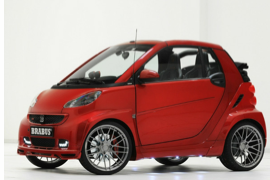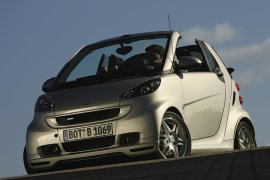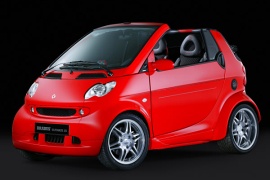SMART fortwo Cabrio Brabus Models/Series Timeline, Specifications & Photos
First production year: 2003
Engines: Gasoline
Body style: Convertible (spider/spyder, cabrio/cabriolet, drop/open/soft top)
Smart introduced the facelifted version of the ForTwo's second generation at the Geneva Motor Show in 2012, and along with it, the Brabus version was also showcased in both versions: convertible and coupe.
Brabus celebrated more than 50,000 units of smart products sold with its name on them. It was the most successful vehicle sold by the Bottrop-based automaker. Its cooperation with the three-pointed-star brand brought helped it survive during the world financial crisis, and their love story continued. As a result, it was just natural to unveil a Brabus-badged product during the Geneva Motor Show, where smart unveiled the facelifted version of the fortwo in both shapes: cabrio and coupe.
At the front, the smoked boomerang-style headlights showed a meaner look. A pair of DRLs accompanied them in the front bumper's apron. A mesh grille adorned the front fascia and resembled some other Brabus performance products. Like the rest of the open-top versions of the fortwo, this one also sported a rag-top that could have been retracted behind the C-pillars that remained in place. Also, from its profile, the small city car revealed its light-alloy wheels that featured a six double-spoke design with three lug-nuts unique for the Brabus version.
The cabin boasted sport bucket seats with Brabus-embroidered headrests. To further emphasize the car's sporty character, the dashboard featured red accents on the instrument cluster and on the sides. In addition, the door cards were adorned with the same color on the handles. These small details made the smart Brabus' owners feel special. It was more of a fashion item than just a transportation device.
But Brabus didn't stop there and also improved the engine performance. Thus, the one-liter, inline-three turbocharged powerplant provided 102 hp, enough to propel the tiny vehicle to 100 kph (62 mph) from standing still in less than nine seconds.
In its quest to stop bleeding money with the small brand, Mercedes-Benz produced a particular version of the ForTwo Cabrio with the well-known tuner company Brabus.
Smart introduced the second generation of the ForTwo in two body shapes: coupe and cabriolet. This time, the carmaker decided to make the car roomier and provide a higher protection level and richer onboard features. All those worked well, but strangely, the customers started to ask for more power from the phone-booth-sized car. Brabus was an expert in that area, so Mercedes-Benz gave it the green light to develop a particular version for the 2007 lineup.
At the front, the 2007 model featured boomerang-shaped headlights above the smiling grille. There was no way how to tell where the bumper was ending, and the rest of the plastic body panels continued. The rag-top was power-operated and retractable behind the seats, while the upper side pillars were removable. Thus, the Smart Cabrio was more of a targa but with a completely open area between the windshield and the B-pillar. Brabus added a touch of its tuner expertise and installed a new set of light-alloy wheels with a six double-spoke design. In the back, it installed a twin exhaust in the middle.
Inside, the Smart Brabus Cabrio received a unique, two-tone interior. The leather-clad bucket seats sported the Brabus logo embroidered into the headrests. On the dashboard, the tuner added aluminum trims, inducing a “racy” experience.
Under the hood, the carmaker installed the same one-liter turbocharged gasoline unit. Brabus took that inline-three Mitsubishi-sourced engine and tuned it to produce 98 hp.
Back in 2003, the German automaker SMART created Brabus versions for its pocket-sized ForTwo model, either with a removable roof or not.
Mercedes-Benz was left alone with the SMART brand after the Swiss watchmaker Swatch pulled back. Their disagreement was about the engine. While the Germans asked for an internal combustion one, their partners said that an electric version would be more suitable. To add insult to injury, Mercedes-Benz not only that it made the SMART with gasoline but also added a pumped-up version. For that, it worked closely with Brabus, which was mostly known for upgrading high-performance Mercedes-Benz cars. This time, it switched its focus to SMART.
As expected, the car's exterior was altered so it could look meaner. The front fascia featured a restyled bumper and a pair of tiny fog lights installed next to a grille. The car needed wider wheel fenders to cover the new wheels. Brabus designed a new set of alloys for the car that resembled the AMG ones from the C-Class. For more pleasant drives, the roof could have been retracted behind the cabin, above the tiny trunk. In addition, the upper side of the safety arch was replaced with a back strut, thus keeping the car safe. In the back, the tuner offered a twin exhaust system with the pipes coming out in the center, under the bumper, with chromed tips.
Inside, Brabus insisted on fitting the car with a few details that made the vehicle more appealing. Its sport-bucket seats with higher bolstering than the regular ForTwo ones. In addition, the car sported a few carbon-fiber trims around the instrument cluster, on the door panels, and on the center stack, depending on the options.
SMART installed the engine under the trunk, and Brabus had to deal with that and upgrade it. In the end, the Brabus engineers managed to squeeze a few more ponies from the tiny three-cylinder engine.


